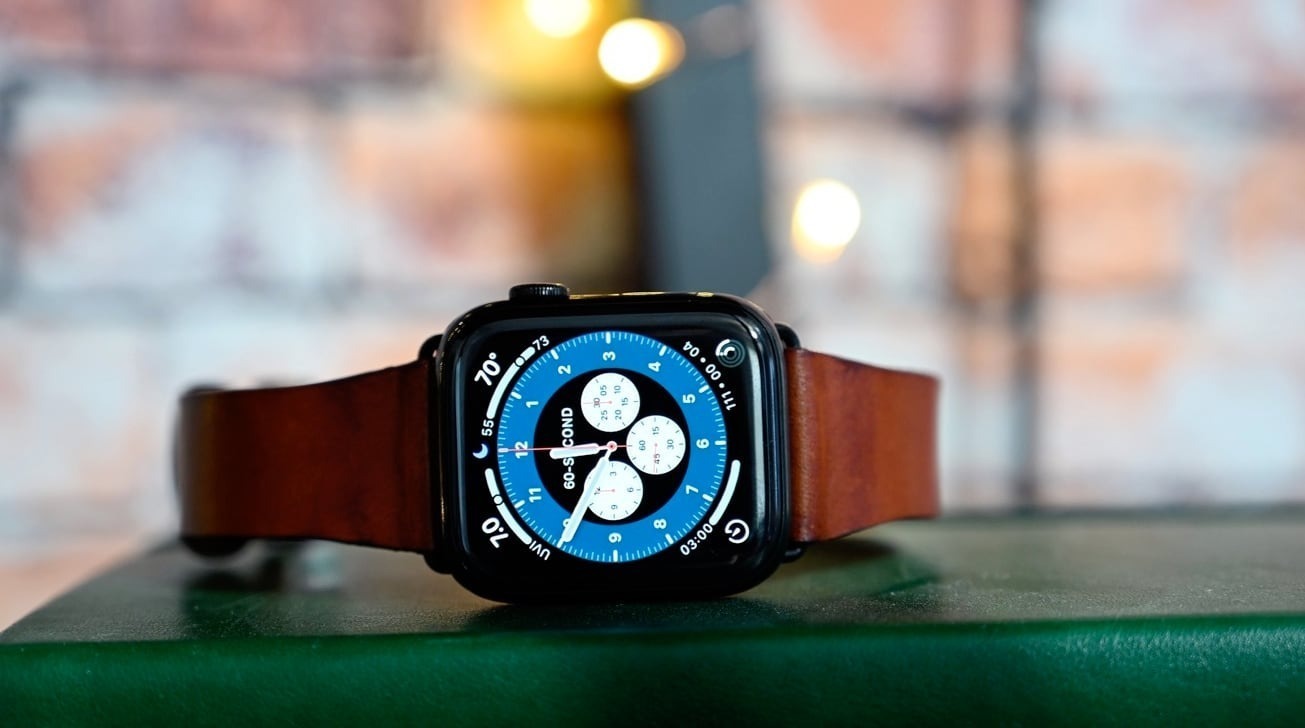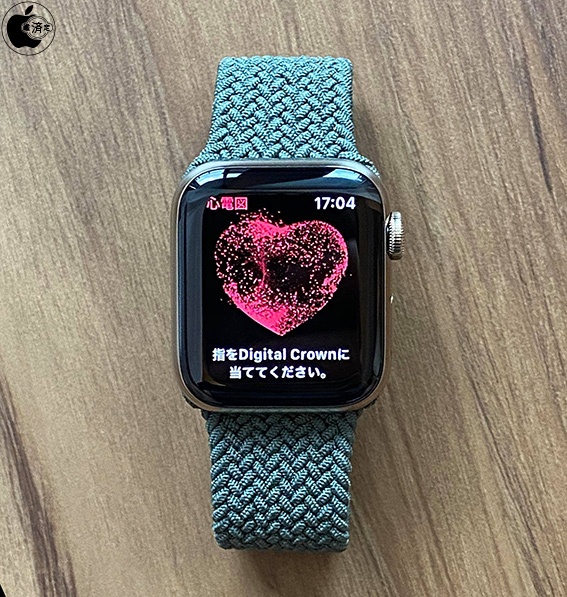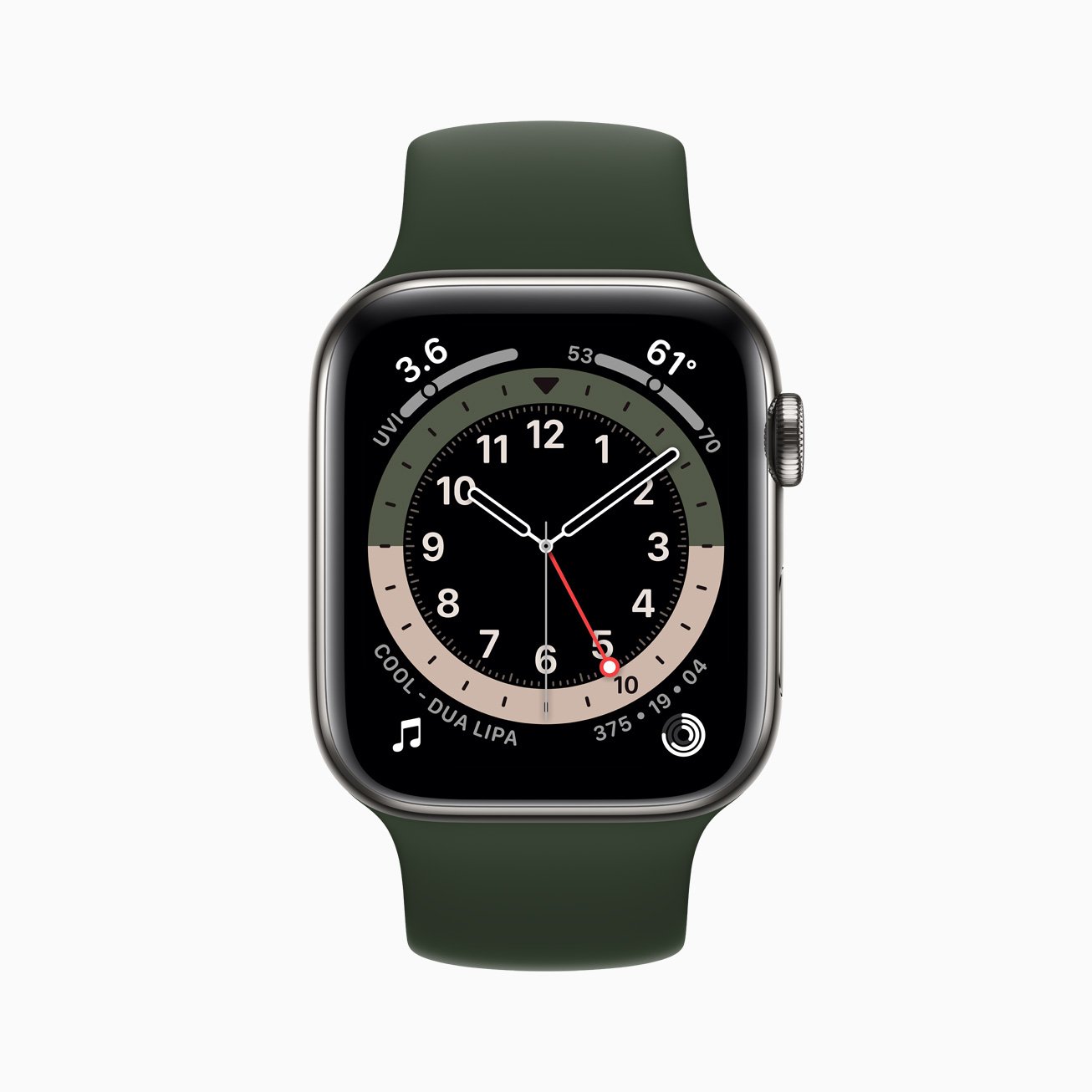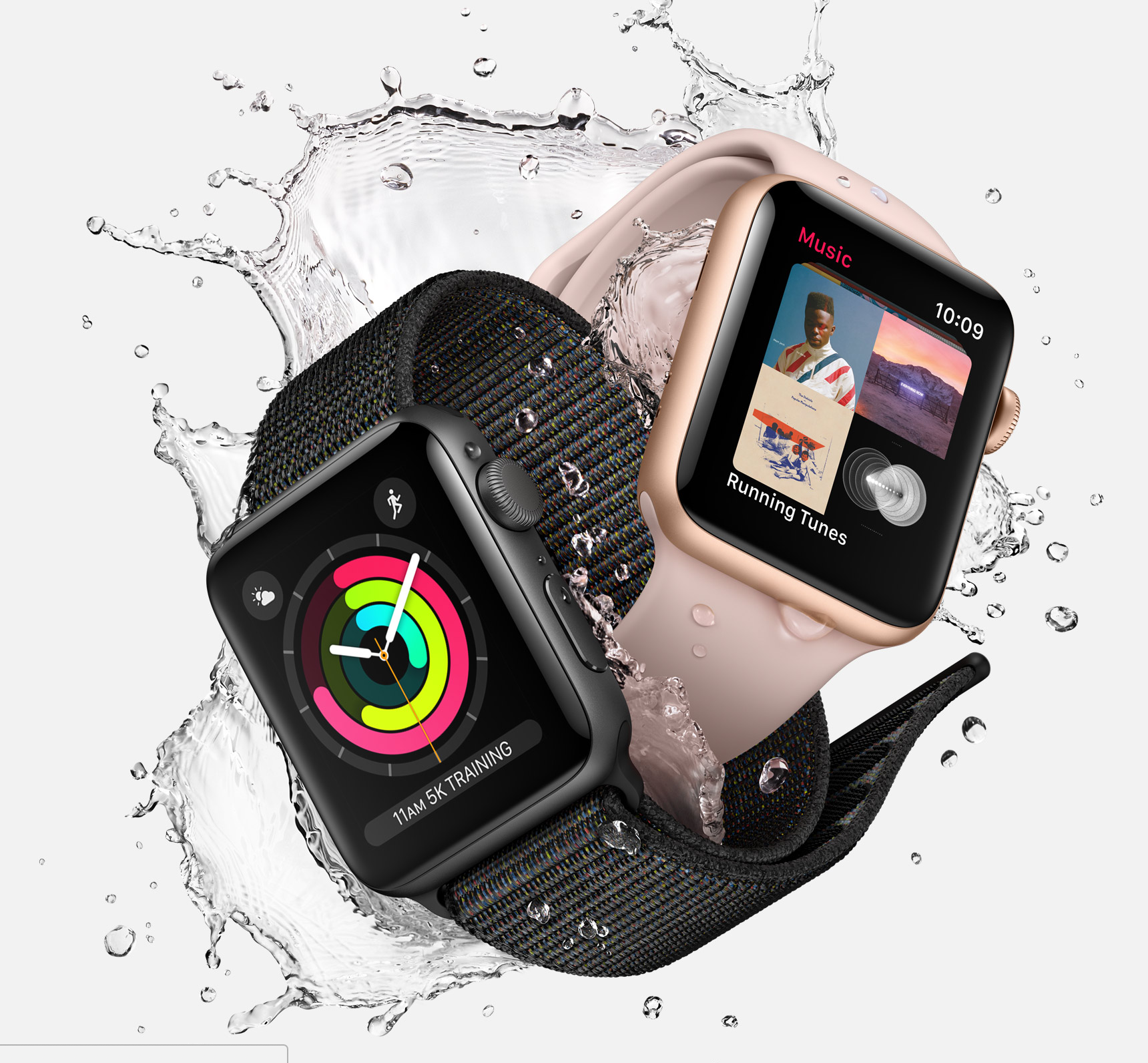The Apple Watch Series 7 offers the same suite of sensors as the Series 6. These include an accelerometer, a gyroscope, a heart rate sensor, a barometer, an always-on altimeter, a compass, an SpO2 sensor, and a VO2 max sensor. These sensors a host of health and fitness tracking features, including blood oxygen monitoring, heart rate monitoring, sleep tracking, fall detection, workout tracking, and more.
On the fitness front, WatchOS 8 features enhanced support for biking. The watch will now be able to detect when you start riding a bike and prompt you to start a cycling workout. Biking workouts now also support auto-pause/resume, as well as fall detection.
With an increased affinity for tracking users on a bike, Apple claims that mid-ride GPS and heart rate detection will improve. The narrower borders allow the display to maximize screen area, while minimally changing the dimensions of the watch itself. With the improvements to the display, users benefit from the same all-day 18-hour battery life,1 now complemented by 33 percent faster charging. Force touch technology has been removed in Watch series 6 and Watch SE. The watch also has a side button which can be used to display recently used apps and access Apple Pay, which is used for contactless payment. The watch then reverts to its original mode when recharged or after holding down the side button. As you would expect, the new version of watchOS 8 brings a number of new health and fitness features.
For starters, there are new workout types — including Pilates and Tai Chi. Now, when sleeping, the Apple Watch will calculate respiratory rate, and that metric will be listed in the Health app. The key USP of the Apple Watch product lineup is its health and fitness features. While Apple hasn't provided any significant additions on that front, you're getting most of the commonly available features to track your health and wellness while on the go. The Apple Watch Series 7 offers blood oxygen saturation tracking using a built-in Blood Oxygen sensor. It is also capable of tracking heart rate using an electrical heart rate sensor that was first introduced on the Apple Watch Series 4 and also available on the last-generation model.
The smartwatch can also detect atrial fibrillation and can provide an electrocardiogram report. Additional features include a new S6 processor that is up to 20% faster than the S4 and S5, a 2.5x brighter always-on display, and an always-on altimeter. The Series 6 watch has been updated with faster charging hardware such that it now completes charging in ~1.5 hours. Force Touch hardware was removed, consistent with the removal of all Force Touch functionality from watchOS 7.
The Apple Watch has always been a health-forward device, and with the latest OS change, users are getting a new way to close their rings. Apple Watch can track dance workouts, core training, functional strength training, and cooldowns. Apple Watch will combine data from the heart rate sensor and accelerometer to track calories burned while dancing accurately. When it was released in September 2020, Apple marketed watchOS 7 as a tool to introduce new watch faces, sleep tracking technology, handwashing detection, and new workout types, among other things.
It also featured aspects like Family Setup, which lets users pair an Apple Watch intended for a family member to their own iPhone. Multiple different updates to watchOS 7 have followed in the last few months, with watchOS 7.3 serving up the latest set of improvements. Apple unveiled the latest versions of its operating systems during WWDC 2020 earlier today.
At its first online-only developers conference, the company unveiled watchOS 7 for the Apple Watch. It will let you track four new types of activities, including dancing, core training, functional strength, and cool down exercises. The dance tracker, for instance, combines data from the heart rate sensor, accelerometer, and gyroscope to measure your calorie burn. Apple will today release its latest software update for the Apple Watch, called watchOS 7, bringing a range of new features including sleep tracking, new watch faces, and updates to Siri and the fitness-tracking app. The ECG system has received clearance from the United States Food and Drug Administration, a first ever for a consumer device, and is supported by the American Heart Association.
This device can also detect falls and will automatically contact emergency services unless the user cancels the outgoing call. The microphone was moved to the opposite side between the side button and the digital crown to improve call quality. Other changes include the digital crown incorporating haptic feedback with the Apple Haptic Engine and includes the new Apple-designed W3 wireless chip. It can keep track of the number of laps and distance during Swimming workouts. During swimming, the touch function can be manually disabled with 'Underwater mode'.
Once this is turned off, by rotating the Digital Crown continuously, it uses the speaker to expel residual water through a series of 10 vibrations. Most recently used apps now are saved in the background, so apps and information load faster. The Series 2 was sold in casings of anodized Aluminium, Stainless Steel and Ceramic.
While the watch has some awareness of how long you were in bed and unconscious, there's no data on the quality of your slumber — nothing on how much deep, dreamy sleep you got versus a light doze. As my colleague Cherlynn Low noted in her Watch SE review, Fitbit and Samsung have a leg up on Apple here, and use heart rate data to map out the user's sleep cycle. It's a shame, too, because the watch itself is surprisingly comfortable to wear to bed.
Just after the launch of the Apple Watch 6 and the Apple Watch SE, watchOS 7 rolled out with a bunch of new features like automatic handwashing detection, sleep tracking, and new watch faces. While the watchOS 7.1 update is rather small in comparison, there are still notable improvements, new features, and bug fixes. The release also comes alongside the release of iOS 14.2 and iPadOS 14.2. After Apple acquired Beddit, it was only a matter of time before the integration of its features in Apple Watch. WatchOS 7 supports sleep tracking, enables Do not Disturb automatically, shows a sleep chart for how many hours of sleep you're getting every night, and even features bedtime reminders and wake-up sounds. There is a Wind Down feature that helps in creating a bedtime routine with various shortcuts that can either open your meditation app or dim your smart lights.
When you wake up in the morning, you are shown the weather, battery status, and even an option to disable your alarm if you woke up earlier. In the age of COVID-19, Apple is adding a new handwashing detection feature to watchOS 7. Using motion sensors to detect handwashing movements and the microphone to listen for the sound of running water, the watch will be able to automatically detect when you wash your hands, and show a 20-second countdown timer. If you stop washing your hands before the time is up, it will encourage you to keep going. Sleep tracking is a standard feature on most fitness trackers and smartwatches these days, so we're happy to see that Apple is finally bringing native sleep tracking to the Apple Watch. When it's time for bed, just set your watch to Sleep Mode, which enables Do Not Disturb and darkens the screen.
Using its accelerometer to detect micro-movements that signal respiration, the watch will keep track of when you're asleep, and how much shut eye you get. There is a rumor floating around that the Series 7 could be the first Apple Watch with a 120Hz refresh rate. Apple is expected to bring this high refresh rate display to the upcoming iPhone 13, which has obvious advantages for a smartphone , but it's a little less clear how it would drastically improve the smartwatch experience. Maybe Apple will make it an optional feature that you can toggle on/off, because the 120Hz refresh rate could take a big hit on the Series 7's battery life. Apple Watch Series 7 was launched at the company's "California streaming" event on Tuesday.
The new Apple Watch model is the eighth iteration in the series of smartwatches launched by the Cupertino giant since its first generation in 2015. The Apple Watch Series 7 comes as a significant upgrade over last year's Series 6, including a major redesign. There are 1.7mm thin borders to maximise display area while barely changing the dimensions of the watch itself. The addition of the new design also enables the Apple Watch Series 7 to deliver the largest-ever display that comes in the 45 millimetres size variant.
Apple claims that using the new design, the Apple Watch Series 7 offers 20 percent more screen area than that of the Apple Watch Series 6, and 50 percent compared to the entry-level Series 3 model. Like clockwork, Apple announced a new Apple Watch model at its September "California Streaming" event alongside the iPhone 13, iPad, and iPad Mini. The Apple Watch Series 7 is the latest flagship and sits atop Apple's current lineup of smartwatches, which still includes the SE and Series 3 rounding out the line. Featuring a slightly revamped design and larger display, the Series 7 comes in either a 41mm configuration starting at $399 or a 45mm configuration — each with optional cellular radios. It brought back the ability for music playing on the iPhone to be controlled using the Music app on the Apple Watch and also enabled control of playback and volume on Apple's HomePod. Other new features included a new charging animation and a new app loading animation.
Activity data was added to the Siri watch face, and the battery complication more accurately reports battery life. The 1st generation Apple Watch uses the single-core S1 system-on-chip. It does not have a built-in GPS chip, instead relying on a paired iPhone for location services. It uses a linear actuator called the "Taptic Engine" to provide haptic feedback when an alert or a notification is received, and is used for other purposes by certain apps. The watch is equipped with a built-in heart rate sensor, which uses both infrared and visible-light LEDs and photodiodes. All versions of the first-generation Apple Watch have 8 GB of storage; the operating system allows the user to store up to 2 GB of music and 75 MB of photos.
When the Apple Watch is paired with an iPhone, all music on that iPhone is also available to be controlled and accessed from the Apple Watch. Software support for the first Apple Watch ended with watchOS 4.3.2. LTE-equipped models can independently connect to a mobile network, including for calling, texting, and installed mobile app data use, substantially reducing the need for an iPhone after initial setup. The oldest iPhone model that is compatible with any given Apple Watch depends on the version of system software installed on each device. As of September 2021, new Apple Watches come with watchOS 8 preinstalled and require an iPhone running iOS 15, which is available for the iPhone 6S and later. Indeed, the company's latest flagship model, the $399 Series 6, has mostly gotten attention for its blood oxygen sensor.
On the software side, watchOS 7 can now track your sleep and handwashing habits and give you cycling directions. Then, later this year, Apple is launching its Fitness+ subscription service, available on older Apple Watches as well. Other than the basic design itself — a square display with a digital crown and mostly familiar lineup of wrist straps — a lot has changed. Gone is the $10,000 solid gold edition that Apple tried selling when the watch first debuted. Nowadays, you can buy an older Apple Watch for as little $199; the new Watch SE starts at $279.
Meanwhile, the fashion executive hired to position the watch as a luxury status symbol has left the company, and the watch is instead being pitched as a health device. Apple Watch Series 1 and Series 2 owners will miss out on Apple's big watchOS 7 upgrade this fall. The new release, which brings sleep tracking and watch face sharing, is compatible with Series 3 devices or later.
The Workouts app in watchOS 7 now supports new types of workouts which include dance, functional strength training, core training, and cooldown. The watch will track all these various workouts differently and sync the data with the Fitness app on your iPhone. Kids can also create their own Memoji using only the Watch itself, and the activity rings normally used to track daily exercise have been optimized for kids.
As parents, you can approve contacts and downloaded apps, and schedule School Time mode, where only the time is available for set hours during the day. It's also easy for family members to share their real-time location using Apple's Find My app. The most compelling benefits of Family Setup are that you can easily see where the people wearing the watches are and communicate with them via text messaging and phone calls. You can also control with whom they can communicate and enforce a restrictedSchooltime mode that helps kids stay focused. Apple Cash Family lets you send money to kids that they can spend via the contactless Apple Pay system. Fall detection, high and low heart rate notifications, and Emergency SOS might be welcome for seniors too.
Apple's watchOS 7 brings sleep tracking, automatic handwashing detection, additional workout options, and more to the Apple Watch. Wallet, for example, will add support for verified digital IDs and digital keys for your home and/or car. Home will allow you to check a HomeKit-enabled doorbell camera from your watch.
Crucially, WatchOS 8 adds the ability to run multiple timers simultaneously without an extra app. Apple released the watchOS 7 last week, alongwith the new Apple Watch Series 6 and the Apple Watch SE. The new OS added new watch features like support for sleep tracking and others. The Cupertino-based tech giant is also continuing to sell the Apple Watch Series 3. However, as per a report by 9to5mac, the Apple Watch Series 3 users aren't happy with the watchOS 7, with several complaints having been lodged via Apple support forums. For any new Apple Watch user aged 18 to 55, fall detection turns on automatically for workouts. Existing users can toggle the feature on themselves in the settings app on the watch or phone or from the Health checklist.
But the smartwatch still has an impressive array of health monitoring features to track ECG, blood oxygen levels, heart rate, and plenty of other metrics. Initial reviews for the device have been generally positive with some caveats. Reviewers praised the watch's potential ability to integrate into everyday life and the overall design of the product, but noted issues of speed and price. Many reviewers described the watch as functional and convenient, while also noting failure to offer as much potential functionality as preceding smartphones. Farhad Manjoo of The New York Times mentioned the device's steep learning curve, stating it took him "three long, often confusing and frustrating days" to become accustomed to watchOS 1, but loved it thereafter. Some reviewers also compared it to competing products, such as Android Wear devices, and claimed "The Smartwatch Finally Makes Sense".
He concluded that there is no "killer application" so far besides telling the time, which is the basic function of a wristwatch anyhow. Each model through Series 3 comes in a 38- or 42-millimeter body, with the larger size having a slightly larger screen and battery. The Series 4 has been updated to 40- and 44-millimeter models, respectively. Featured Apple-made bands include colored sport bands, sport loop, woven nylon band, classic buckle, modern buckle, leather loop, Milanese loop, and a link bracelet.
There are also two third-party bands, Artenix and Wristcam, which give on-the-go charging capabilities and a built-in camera to the watch, respectively. The Series 7 is also equipped with new hardware that enables ultra-rapid, short-range wireless data transfer at 60.5GHz, though Apple has not fully explained this new functionality. In comparison to other Apple products and competing smartwatches, marketing of the Apple Watch promoted the device as a fashion accessory.
Apple later focused on its health and fitness-oriented features, in an effort to compete with dedicated activity trackers. The watchOS 3 added fitness tracking for wheelchair users, social sharing in the Activity app, and a Breathe app to facilitate mindfulness. Apple earlier today released watchOS 7.6 for Apple Watch users, which brings some bug fixes and also enables the ECG app in more regions.
According to Apple, both ECG and irregular heart rate notifications are now available in 30 additional countries. It seems Apple instead used its resources to build out so-called wind-down and wake-up routines. Using the Health app, you can set goals, like how much sleep you want, or when you'd like to get in bed each night. Dig deeper into the settings and you can decide to have your phone automatically enter sleep mode and turn on Do Not Disturb when Wind Down time begins. Additionally, you can opt to still show the time on your phone and watch during sleep mode and, separately, opt into sleep reminders.
As for watchOS 7, which can run on Apple Watches as old as the Series 3, it brings enough new features to make it a fun and worthwhile upgrade — even for people who have no intention of trading in their device anytime soon. Sleep tracking will come to the new Apple Watch finally, and an updated Sleep section in the health app will include all the information you want to see on your nighttime activities. The activity app is being renamed Fitness and Apple is improving the tracking of some of the fitness options including dance. With it, the company brings in a number of new tweaks and improvements to all supported Apple Watches. The developer beta is now live at developer.apple.com and the public beta will be made available to users next month via beta.apple.com. The Apple Watch Series 7 is also capable of providing an enhanced sleep tracking, with features including sleeping respiration rate and sleep trends.



























